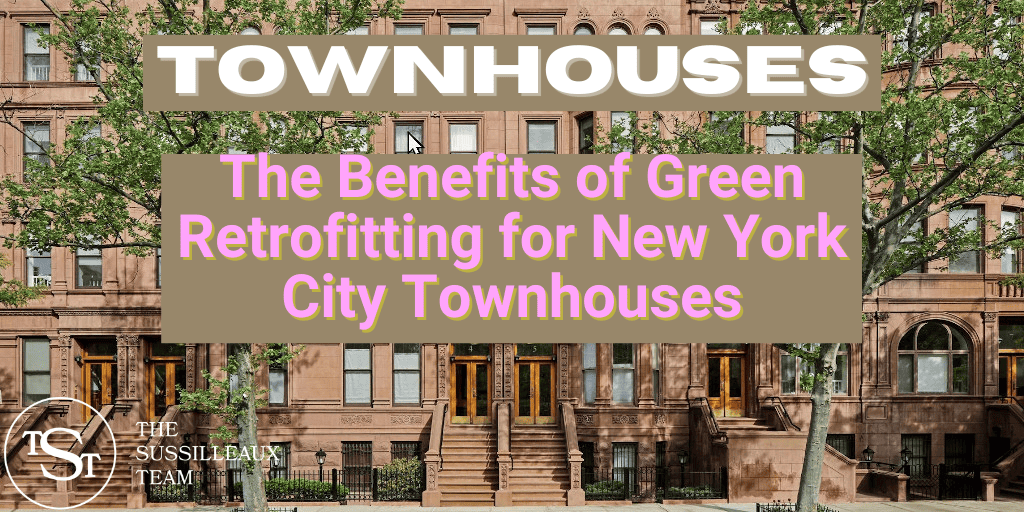Understanding Green Retrofitting for Manhattan Townhouses
Green retrofitting is the process of upgrading existing buildings with sustainable technologies and materials to improve energy efficiency, reduce environmental impact, and enhance occupants’ well-being. Manhattan townhouses are prime candidates for these upgrades, as they often feature older building techniques and materials that are less energy efficient. By adopting green retrofitting measures, homeowners in Manhattan can improve their living spaces while contributing to a more sustainable urban environment.
Over the years we have noticed an increased trend towards “going green”. Most notably, the trend away from oil-fired boilers to natural gas. We also see a lot more solar panels, efficient HVAC systems, and thermally efficient windows. (Where allowed by building codes and Landmarks)
I don’t think it’s practical to do everything we offer in this article, but almost every townhouse can benefit by some green retrofitting.
Environmental Benefits of Green Retrofitting
Green retrofitting offers numerous environmental advantages, including:
Reduced Energy Use
Green energy retrofitting of your Manhattan townhouse can significantly reduce energy use. This can be achieved through various means, such as upgrading to energy-efficient appliances, installing solar panels, or improving the insulation of your home. Reduced energy consumption not only benefits the environment, but it also leads to substantial savings on energy bills over time.
Improved Indoor Environmental Quality
Through green retrofitting, you can significantly improve the indoor environmental quality of your townhouse. This can be achieved by using non-toxic materials, improving ventilation systems, and introducing natural light. These modifications can result in improved air quality, reduced noise levels, and an overall more comfortable and healthier living environment.
Lower Global-Warming Greenhouse Gas Emissions
By reducing your townhouse’s energy consumption, you’re also lowering its greenhouse gas emissions. Residential buildings account for a significant portion of the overall emissions, mainly through heating, cooling, and electricity use. Green retrofitting can thus contribute to the global fight against climate change by reducing your home’s carbon footprint.
Reduced Utility and Maintenance Bills
The energy savings that come with green retrofitting result in lower utility bills. Additionally, green retrofitting often involves upgrading to more durable, efficient systems and materials, which can reduce maintenance costs. Over time, these savings can offset the initial investment in green retrofitting.
Increased Resale Value
Green retrofitted homes often command higher prices on the real estate market. As energy efficiency and sustainability become increasingly important to buyers, a green-retrofitted townhouse can stand out from the competition. This can increase the appeal of your property and potentially lead to a higher resale value.
PRO TIP: What are buyers looking for?
Energy savings are always a positive selling point, but let’s be honest: In the real world of New York City townhouses, the value of the home is so far in excess of utility and energy bills, that very few owners will sweat the financial burden.
Where it really comes into play is when it is either a multifamily property where the margins are slimmer or when it is a single-family home, but only occupied part of the time. It’s very useful to be able to maintain an “away from home” mode for the environmental systems.
Adhered – No Thermal Bridging
A critical aspect of green retrofitting is ensuring that the insulation is adhered, meaning there are no gaps or breaks that allow heat to escape or enter, a phenomenon known as thermal bridging. By preventing thermal bridging, you can enhance the efficiency of your home’s heating and cooling systems, further reducing energy use and improving comfort.
Continuous Insulation and Airtight Envelope
Creating a continuous layer of insulation and an airtight envelope is another essential feature of green retrofitting. This involves sealing all potential air leaks and providing a continuous layer of insulation across all parts of the building envelope – the barrier between the interior and exterior of your home. This not only reduces energy use but also prevents moisture issues, thereby enhancing the longevity and durability of your townhouse.
Promoting sustainable building practices
Green retrofitting encourages the use of sustainable building materials, such as reclaimed wood, recycled metal, and low VOC (volatile organic compound) paint. These materials minimize the environmental impact of construction and renovation projects and promote a more sustainable building industry.
Conserving natural resources
By implementing water-saving measures and using renewable energy sources, green retrofitting helps conserve vital natural resources like water and fossil fuels. This is crucial for preserving the planet for future generations.
Financial Benefits of Green Retrofitting
In addition to environmental advantages, green retrofitting offers several financial benefits:
Lowering energy costs
Energy-efficient upgrades, such as improved insulation and high-performance windows, can significantly reduce heating and cooling expenses. Over time, these savings can offset the initial cost of green retrofitting.
Increasing property value
Green retrofitted townhouses typically have higher resale values due to their energy efficiency, lower maintenance costs, and modern, eco-friendly features. This makes them attractive to potential buyers who are increasingly conscious of sustainability issues.
Accessing government incentives and tax credits
Several local, state, and federal incentives are available to help offset the cost of green retrofitting projects. These can include tax credits, rebates, and low-interest financing options for energy-efficient upgrades.
Reducing maintenance and repair costs
Sustainable building materials and technologies often have longer lifespans and lower maintenance requirements than traditional alternatives. This can lead to long-term savings in maintenance and repair costs for Manhattan townhouse owners.
Health and Comfort Benefits of Green Retrofitting
Green retrofitting can potentially improve the health and comfort of residents:
Improving indoor air quality
By using low VOC paints, sealants, and adhesives, as well as incorporating proper ventilation systems, green retrofits can significantly improve indoor air quality. This helps create a healthier living environment, particularly for those with respiratory issues or allergies.
In a city like New York, air quality is a great concern. While pollution has abated over the years as manufacturing and automobile traffic wane, air quality is still a concern – particularly with allergens.
Enhancing thermal comfort
High-quality insulation, energy-efficient windows, and advanced HVAC systems help maintain consistent indoor temperatures, making homes more comfortable throughout the year. Improved thermal comfort can also lead to better sleep and overall well-being.
Reducing noise pollution
Insulation and high-performance windows not only improve energy efficiency but also help reduce noise pollution from outside sources. This is especially important in densely populated areas like Manhattan, where traffic and construction noise can be significant.
Creating a healthier living environment
Overall, green retrofitting contributes to a healthier living environment by reducing exposure to harmful chemicals, improving indoor air quality and creating comfortable, well-regulated living spaces. These factors contribute to an enhanced quality of life for residents of green retrofitted Manhattan townhouses.
Key Green Retrofitting Strategies for NYC Townhouses
Several strategies can be implemented to effectively green retrofit a Manhattan townhouse:
Energy-efficient windows and insulation
Upgrading to double- or triple-pane windows and installing high-quality insulation can significantly reduce heat loss and gain, improving the building’s overall energy efficiency.
High-efficiency heating and cooling systems
Replacing older HVAC systems with newer, high-efficiency models can greatly decrease energy consumption while maintaining comfortable indoor temperatures.
Water conservation and efficient plumbing
Installing low-flow faucets, showerheads, and toilets, as well as using greywater recycling systems, can help conserve water and reduce utility bills.
Solar panels and renewable energy sources
Solar panels and other renewable energy sources, such as wind turbines or geothermal heat pumps, can provide clean, sustainable power for a townhouse, further reducing its environmental impact.
Green roofs and outdoor spaces
Green roofs and landscaped outdoor spaces can help manage stormwater runoff, improve air quality, and provide additional insulation for the building.
Sustainable building materials and finishes
Utilizing eco-friendly materials, such as reclaimed wood, recycled metal, and low VOC paint, can reduce a renovation project’s environmental impact and contribute to a healthier living space.
Planning and Implementing a Green Retrofit for Your Manhattan or Brooklyn Townhouse
To successfully execute a green retrofit, homeowners should follow these steps:
Assessing your townhouse’s current energy performance
Conduct an energy audit to identify areas where improvements can be made and to establish a baseline for measuring the effectiveness of green retrofitting efforts.
Setting sustainability goals and priorities
Establish clear objectives for the retrofit, such as reducing energy consumption, improving indoor air quality, or obtaining green building certifications. Prioritize projects based on their potential impact and return on investment.
Hiring experienced professionals
Work with green architects, designers, contractors, and consultants who have experience in sustainable building practices and can guide you through the retrofit process.
Green architects and designers
These professionals can help you develop a comprehensive plan for your green retrofit, incorporating sustainable technologies and materials that align with your goals and budget.
Sustainable contractors and consultants
Choose contractors and consultants who specialize in green building to ensure that your project is executed according to best practices and meets all relevant codes and regulations.
Navigating permits and regulations for green retrofits
Familiarize yourself with local building codes and permit requirements related to green retrofitting. Working with experienced professionals can help streamline this process and ensure compliance.
Case Studies: Successful Green Retrofitting Projects in Manhattan
Learn from the experiences of others who have successfully completed green retrofit projects:
Examples of green townhouse renovations
Research local examples of green retrofitted townhouses to gain inspiration and insights into the process. These case studies can provide valuable lessons about what works well and potential challenges to anticipate.
Lessons learned from successful projects
Identify common themes and best practices from successful green retrofit projects, such as the importance of setting clear goals, working with experienced professionals, and prioritizing high-impact upgrades.
Inspiration for your own green retrofit
Use these case studies as a starting point for envisioning how your own Manhattan townhouse could benefit from green retrofitting and the potential improvements that could be made.
Conclusion
Green retrofitting offers numerous environmental, financial, and health benefits for Manhattan townhouse owners. By implementing sustainable upgrades, homeowners can create healthier, more energy-efficient living spaces while contributing to a greener urban environment. Embracing green retrofitting strategies can lead to long-term savings, increased property value, and a positive impact on the planet. With proper planning, expert guidance, and informed decision-making, Manhattan townhouse owners can transform their homes into eco-friendly, comfortable, and future-proof living spaces.
Further reading
You can return to The Complete Guide to Manhattan Townhouses, or go to the preceding article in the Renovating Manhattan Townhouses series: Understanding Permits and Regulations for Manhattan Townhouse Renovations, or move on to the next article in the section: Manhattan Townhouse Maintenance: What You Need to Know
Frequently Asked Questions (FAQs)
Frequently Asked Questions (FAQs)
- How much does a green retrofit typically cost for a Manhattan townhouse?
- Are there government incentives or tax credits available for green retrofits?
- Can I implement green retrofitting strategies in a historic Manhattan townhouse?
- How do I know if my townhouse is a good candidate for green retrofitting?
- What is the best way to prioritize green retrofitting strategies for my Manhattan townhouse?
How much does a green retrofit typically cost for a Manhattan townhouse?
The cost of a green retrofit varies depending on the scope of the project, the specific technologies and materials used, and the size of the townhouse. It’s essential to create a detailed budget and work with experienced professionals who can help estimate costs accurately and identify the most cost-effective upgrades.
Are there government incentives or tax credits available for green retrofits?
Yes, there are various local, state, and federal incentives and tax credits available for green retrofit projects. These can include tax credits for energy-efficient appliances, renewable energy systems, and building materials. Be sure to research available incentives and consult with a tax professional to determine eligibility.
Can I implement green retrofitting strategies in a historic Manhattan townhouse?
Yes, green retrofitting can be implemented in historic buildings, but it may require extra care and planning to preserve the architectural integrity of the structure. Work with experienced professionals who specialize in green retrofits for historic buildings and consult with local preservation organizations to ensure compliance with any applicable regulations.
How do I know if my townhouse is a good candidate for green retrofitting?
Most townhouses can benefit from green retrofitting, especially older buildings with outdated systems and materials. Start by conducting an energy audit to identify areas of improvement and prioritize upgrades based on potential impact and return on investment.
What is the best way to prioritize green retrofitting strategies for my Manhattan townhouse?
Begin by establishing clear sustainability goals and priorities for your project. Then, consult with experienced professionals to identify the most effective and cost-efficient strategies for achieving these objectives. Factors to consider when prioritizing upgrades include the potential impact on energy savings, indoor air quality, and comfort, as well as the projected return on investment.





